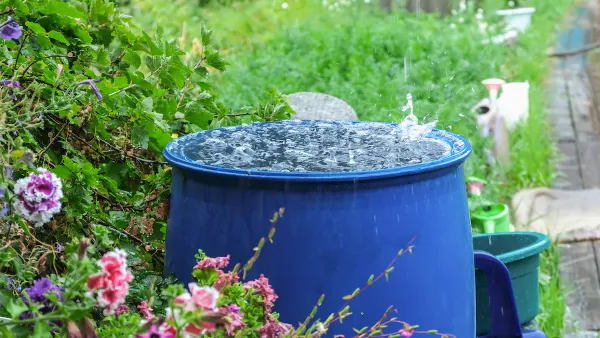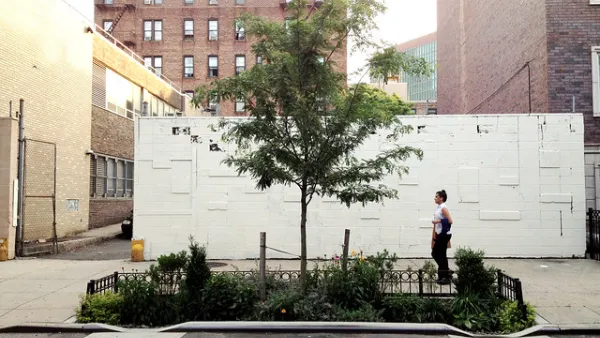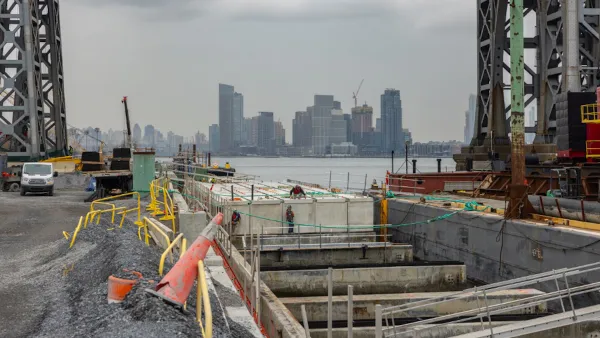It can’t help cities control the weather, but by slowing the flow of stormwater, permeable pavement can lessen flooding from big storms.
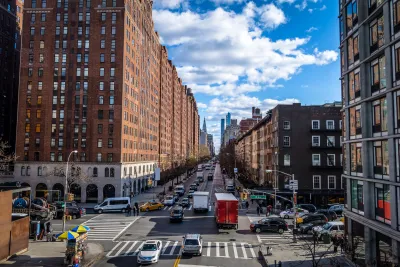
This story was originally published on Reasons to Be Cheerful. Read the original story here.
Among the kosher markets, eateries and synagogues of Brooklyn’s Borough Park neighborhood, a quiet transformation is underway. On a recent overcast Saturday, the intersection of 37th Street and 12th Avenue looked like any other intersection in the area, surrounded by single-family homes and parking garages. But an important measure to mitigate mass flooding was implemented here last month, when New York’s Department of Environmental Protection (DEP) began to install seven miles of permeable pavement along curb lines.
Pavement covers so much of the urban landscape, but most of us probably don’t think much about how it impacts the flow of water through our cities — until a hurricane or big rainstorm hits, and stormwater runs swiftly right off of it. The catastrophic flooding that hit parts of New York, New Jersey and Connecticut last weekend was the latest example of how sudden and dramatic the impact of such storms can be.
When storms produce widespread torrential rains, floods from storm surge can cause serious damage to our sewer systems. As we approach the peak months of the Atlantic hurricane season, the risk for flooding and storm surge increases. The National Oceanic and Atmospheric Administration (NOAA) projected that the 2024 hurricane season would be above normal, and rapid hurricane intensification has become more common in recent years.
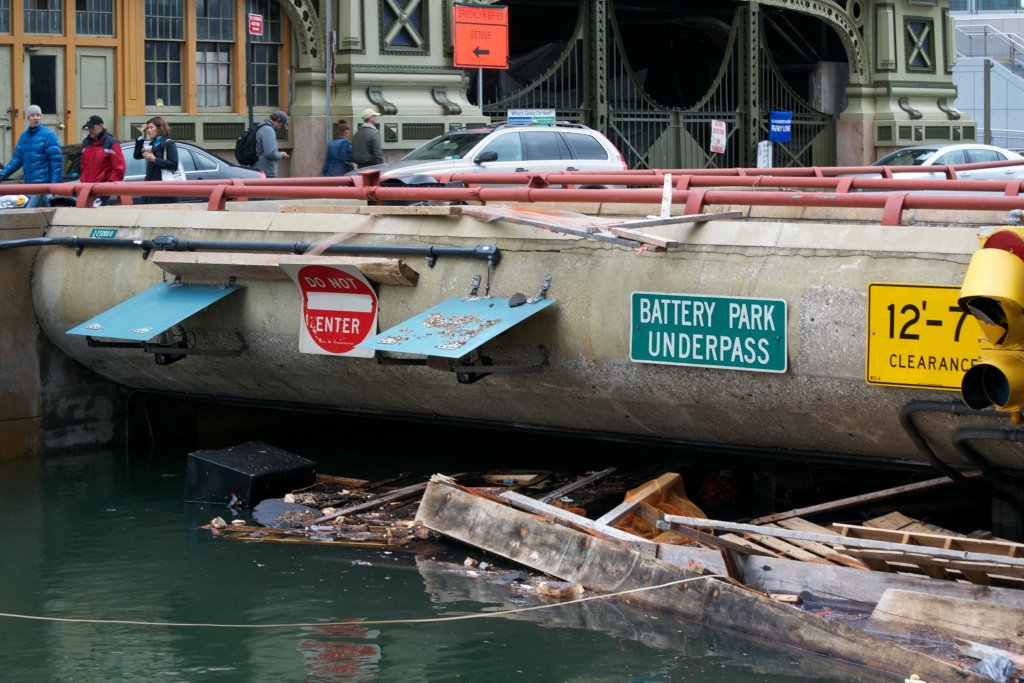
But experts suggest that permeable pavement could help cities across the United States improve their stormwater resilience. Already, cities and counties like Cleveland, Kansas City and California’s Orange County have put permeable pavement to use to comply with the US Environmental Protection Agency’s stormwater regulations. In Borough Park, it’s being strategically installed along curb lines — where the street meets the sidewalk and water drains toward catch basins.
According to Elizabeth Hiser, a stream restoration ecologist for Cleveland Metroparks, permeable pavement is designed to get water back into the soil, as a way of mimicking what greenery would have naturally done before there were driveways, parking lots, streets and roofs.
In urbanized systems, water runs off and it does not absorb into the ground. Permeable pavement can help recharge and decrease the flow of runoff events. And unlike other interventions that might require pavement to be replaced by vegetation, permeable pavement can also help densely built cities keep what they already have: “One of the reasons cities like this practice is because you get a multi-use out of it. You don’t have to give up your parking, but you also get stormwater benefits, which are in demand in cities like New York,” says Hiser.
Of course, permeable pavement can’t help cities control the weather, but by slowing down the flow of stormwater, it can help them absorb larger quantities of it.
Before buildings and roadways, New York City was a wet, forested place. When storms came, wetlands were capable of capturing water, which would slowly permeate into the soil and eventually drain out into the waterways. But that was a long time ago, before New York was a dense, pavement-filled city.“We’ve built sewer systems to manage stormwater that’s falling down on the footprint of our city, but our system was built for a climate that no longer exists,” says Despo Thoma, a landscape architect and director of resilience at the New York-based firm SCAPE. “We are in a changed climate with way more extreme events and way more frequent storms. So what used to be a system that was able, in an ideal condition, to handle a storm event, cannot anymore.”
Two major storm events in recent years brought home the city’s shortcomings: Superstorm Sandy in 2012 and Hurricane Ida in 2021. In 2012, the Rockaways in Queens were particularly hard-hit. And in certain communities in the southern parts of Queens, Brooklyn and Manhattan, the subway system and road tunnels flooded when water rose above the normally expected high tide. Then in 2021, Ida’s extreme rainfall broke records. Rain fell faster than it could drain away through stormwater infrastructure, causing flooding, especially in basement apartments.
Thoma adds that in extreme rainfall events, “it’s hard for our sewer system to handle large quantities of water coming into it. Which means that parks, yards and streetscapes need to absorb water as fast as they can.”
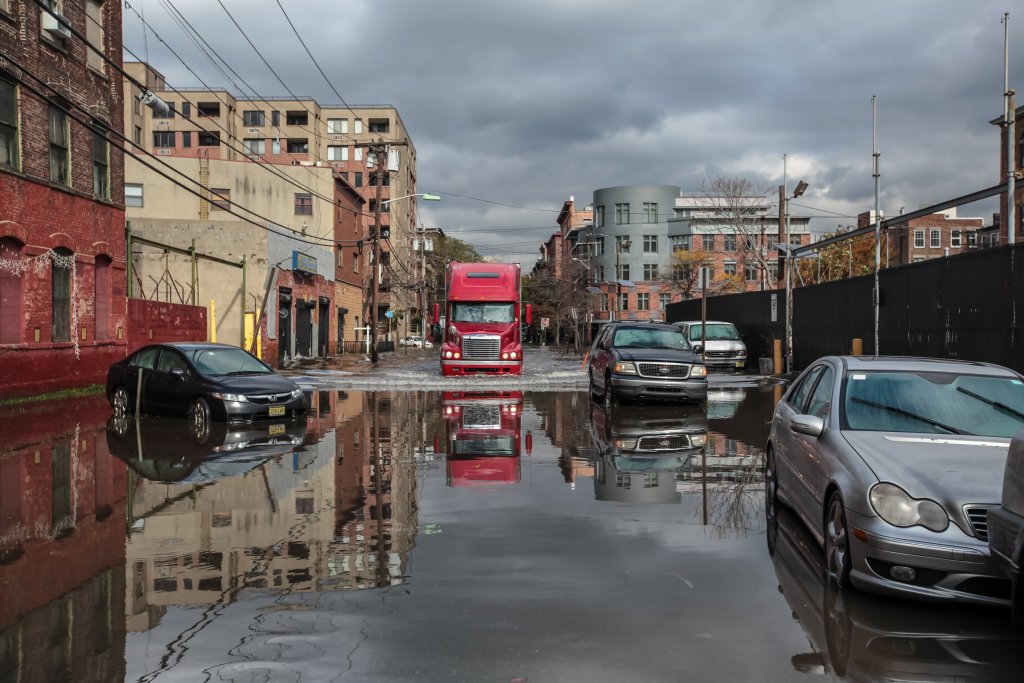
In the future, permeable pavement could make a real difference. In June, New York City completed a $16.6 million infrastructure project in the Rockaways — among the communities most affected by flooding from Superstorm Sandy — which included 11,000 square feet of permeable concrete along curb lines, capable of absorbing almost 1 .3 million gallons of water to prevent it from flowing into the sewer system. Other cities have also been preparing in recent years for extreme rainfall events by making themselves more “spongier”: In Los Angeles, nine inches of rain fell over the course of just three days in February. Thanks to the replacement of concrete with dirt, plants and “spreading grounds,” the city was able to capture 8.6 billion gallons of stormwater — enough to provide 106,000 households with water for a year.
Rohit T. Aggarwala, New York City’s chief climate officer and commissioner of the DEP, said in a release that more projects like this will be implemented in the city in the coming years. The seven miles of porous road in Borough Park are just the beginning, with more green infrastructure planned for communities in the Bronx and Queens over the next two decades.
Permeable pavement is only one part of the puzzle when it comes to improving the way water flows through cities like New York. “It’s about building layers of resilience in our cities in multiple ways,” says Thoma, “and then all together, it makes us more resilient so that we can withstand larger challenges.”
Valeria Morales is Reasons to be Cheerful’s summer 2024 editorial intern. She is a journalist from Puerto Rico, currently attending the Craig Newmark Graduate School of Journalism in New York with a focus on the Latinx community.

National Parks Layoffs Will Cause Communities to Lose Billions
Thousands of essential park workers were laid off this week, just before the busy spring break season.

Retro-silient?: America’s First “Eco-burb,” The Woodlands Turns 50
A master-planned community north of Houston offers lessons on green infrastructure and resilient design, but falls short of its founder’s lofty affordability and walkability goals.

Delivering for America Plan Will Downgrade Mail Service in at Least 49.5 Percent of Zip Codes
Republican and Democrat lawmakers criticize the plan for its disproportionate negative impact on rural communities.

Test News Post 1
This is a summary

Test News Headline 46
Test for the image on the front page.

Balancing Bombs and Butterflies: How the National Guard Protects a Rare Species
The National Guard at Fort Indiantown Gap uses GIS technology and land management strategies to balance military training with conservation efforts, ensuring the survival of the rare eastern regal fritillary butterfly.
Urban Design for Planners 1: Software Tools
This six-course series explores essential urban design concepts using open source software and equips planners with the tools they need to participate fully in the urban design process.
Planning for Universal Design
Learn the tools for implementing Universal Design in planning regulations.
EMC Planning Group, Inc.
Planetizen
Planetizen
Mpact (formerly Rail~Volution)
Great Falls Development Authority, Inc.
HUDs Office of Policy Development and Research
NYU Wagner Graduate School of Public Service


























